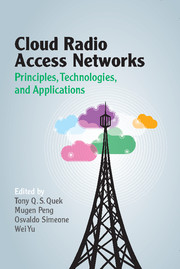Book contents
- Frontmatter
- Contents
- Acknowledgments
- Foreword
- Preface
- List of Contributors
- Part I Architecture of C-RANs
- Part II Physical-Layer Design in C-RANs
- 3 The Tradeoff of Computational Complexity and Achievable Rates in C-RANs
- 4 Cooperative Beamforming and Resource Optimization in C-RANs
- 5 Training Design and Channel Estimation in C-RANs
- 6 Massive MIMO in C-RANs
- 7 Large-Scale Convex Optimization for C-RANs
- 8 Fronthaul Compression in C-RANs
- 9 Adaptive Compression in C-RANs
- Part III Resource Allocation and Networking in C-RANs
- Part IV Networking in C-RANs
- Index
- References
9 - Adaptive Compression in C-RANs
from Part II - Physical-Layer Design in C-RANs
Published online by Cambridge University Press: 23 February 2017
- Frontmatter
- Contents
- Acknowledgments
- Foreword
- Preface
- List of Contributors
- Part I Architecture of C-RANs
- Part II Physical-Layer Design in C-RANs
- 3 The Tradeoff of Computational Complexity and Achievable Rates in C-RANs
- 4 Cooperative Beamforming and Resource Optimization in C-RANs
- 5 Training Design and Channel Estimation in C-RANs
- 6 Massive MIMO in C-RANs
- 7 Large-Scale Convex Optimization for C-RANs
- 8 Fronthaul Compression in C-RANs
- 9 Adaptive Compression in C-RANs
- Part III Resource Allocation and Networking in C-RANs
- Part IV Networking in C-RANs
- Index
- References
Summary
Cloud radio access networks (C-RANs) provide a promising architecture for the future mobile networks needed to sustain the exponential growth of the data rate. In C-RAN, one data processing center or baseband unit communicates with users through distributed remote radio heads, which are connected to the baseband unit (BBU) via high-capacity low-latency so-called fronthaul links. The architecture of C-RAN, however, imposes a burden of fronthaul bandwidth because raw I/Q samples are exchanged between the RRHs and the BBU. Therefore, signal compression is required on fronthaul links owing to their limited capacity. This chapter exploits the advance of joint signal processing to reduce the transmission rate on fronthaul uplinks. In particular, we first propose a joint decompression and detection (JDD) algorithm which exploits the correlation among RRHs and jointly performs decompressing and detecting. The JDD algorithm takes into consideration both fading and quantization effects in a single decoding step. Second, the block error rate of the JDD algorithm is analyzed in a closed form by using pairwise error probability analysis under both deterministic and Rayleigh fading channel models. Third, on the basis of the analyzed block error rate (BLER), we introduce adaptive compression schemes subject to quality of service constraints to minimize the fronthaul transmission rate while satisfying the predefined target QoS. The premise of the proposed compression methods originates from practical scenarios, where most applications tolerate a non-zero BLER. As a dual problem, we also develop a scheme to minimize the signal distortion subject to the fronthaul rate constraint. We finally consider the counterparts of these two adaptive compression schemes for Rayleigh-fading channels and analyze their asymptotic behavior as the constraints approach extremes.
Introduction
Cloud radio access networks have been widely accepted as a new architecture for future mobile networks to sustain the ever increasing demand in the data rate [1]. In a C-RAN, one centralized processor or BBU communicates with users distributed in a graphical area via a number of remote radio heads (RRHs), which act as “soft” relaying nodes and are connected to the BBU via high-capacity and low-latency fronthaul links. By moving all baseband processing functions from RRHs to a centralized processor, the C-RAN enables adaptive load balancing via a virtual base station pool [2] and effective network-wide inter-cell interference management thanks to multi-cell processing [3, 4].
Information
- Type
- Chapter
- Information
- Cloud Radio Access NetworksPrinciples, Technologies, and Applications, pp. 200 - 224Publisher: Cambridge University PressPrint publication year: 2017
